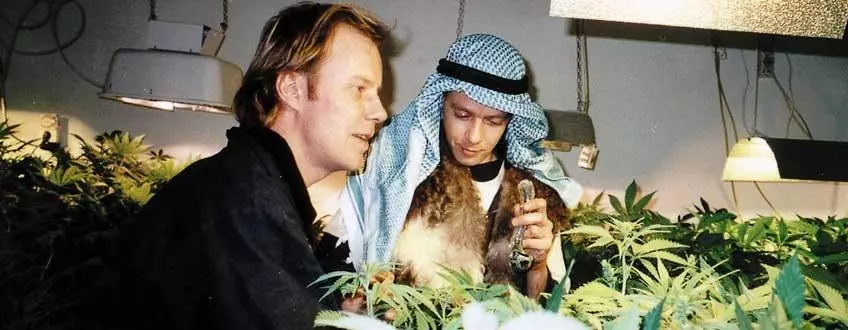History is important. This is something we have been realising over the course of this year as we celebrate 25 years in the cannabis industry. This has started many conversations about our Paradise Seeds history and how we started in the business.
One thing we have realized is how important history is in the cannabis industry. It’s something you can’t buy (or simulate with shiny marketing) and after 25 years of still being here, it tells you that there is a product to be trusted! So let’s take a little walk back in time and revisit some Paradise Seeds history!
Our founder, Luc, first planted a cannabis seed in the back garden of his parents’ house in the early 1980s and fell in love with the cannabis plant he grew! That first plant (which was grown from a seed that had originally come from the island of Aruba in the Caribbean) started him on a journey which would officially become Paradise Seeds, the company, in 1994.
The Squat Years: An Experimental Era!
Amsterdam in the late 1980s and early 1990s was a very different city to the one we know now. Its beauty lay in the traditional face of its buildings and canals, but there was also much urban decay. Many of those grand old buildings were abandoned and crumbling. This abundance of deserted city buildings fuelled a thriving ‘squat’ scene with the spaces being colonized by a youthful and progressive crowd.
As well as becoming living spaces, these sites became a focus for arts, music, politics and the language of liberation. Luc arrived in Amsterdam in the late 1980s and began living in squats, enthused by the vibrancy of the scene with its creativity, mad parties (that often lasted for days!) and sense of do-it-yourself innovation.
“It was a very tolerant time,” remembers Luc. “The vibe at that time was still influenced by the hippy era and there was a real culture of ‘anything goes’. This was also true with the authorities attitudes towards cannabis. The police weren’t too concerned about weed and hash as their priority was heroin, which was a big problem in Amsterdam at the time. As a result, you could walk around with a kilo in your bag and not have to worry. You could also grow a lot of weed plants without having to worry about getting busted!”
This tolerant attitude made the city a magnet for cannabis travelers (from the UK, Europe and the USA) – many of them using it as a stopover between travels to and from India, Pakistan, Afghanistan and other countries in Asia, which was known back then as the ‘Hippy Trail’. They would bring hash back with them and sell it in Amsterdam, but also would return with cannabis landrace seeds. Also at that time, there was an ex-pat community of American cannabis heads who had fled the War on Drugs in their own country. They also brought seeds as well as their cultivation knowledge.
This is the scene that existed in the 1980s and the roots of Paradise Seeds history can be traced back to here. Living in a squat, Luc began to experiment with growing cannabis. He began collecting seeds and growing them on the roof of the building; “There were a lot of buckets filled with soil and a lot of different plants at all stages of the growing process,” he says of this time. When winter came, he moved inside, setting up a very rudimentary indoor grow. In the days before an established cannabis grow equipment industry, necessity was the mother of invention and the indoor rooms were filled with fluorescent light tubes (on the ceiling, floors and walls!). It was during this time that he began to really experiment with cross pollination, phenotype selection and back crossing.
New Strains: Enter The Dutch Dragon!
From this basic breeding process emerged three original strains. The first was christened ‘Amsterdam Flame’, which was a Kerali (Southern Indian) seed, crossed with an outdoor Skunk which had been adapted to the Dutch climate (its home was the roof of the building that housed the legendary Grasshopper coffee shop). The second was ‘Dutch Dragon‘ – a strain that lives on in the Paradise Seeds collection (although it has changed quite a bit from those early days). These were the first strains available from Paradise Seeds when the company was formed in 1994.
Sensi Star Becomes Champion of the Cannabis World!
The third strain was ‘Sensi Star‘ (short for Sensimillia, which was the gold standard weed at the time – the origin of the name coming from Spanish ‘sin semilla’ meaning ‘without seed’). This strain played a pivotal role in the Paradise Seeds history. At the time, Luc says that he knew Sensi Star was a special plant. It was the combination of Afghani and Indian genetics and Skunk genetics which were then back crossed with an Afghani and the selection process was made over hundreds of plants. The result was an incredibly resinous indica plant with so many trichomes and a very unique taste.
In 1999 the Paradise Seeds crew arrived at the High Times Cup in Amsterdam as a small player on the seed scene, but that changed overnight. The crew brought along some Sensi Star plants and people could not believe what they saw. The previous year had been all about White Widow and its amazing trichome count, but here was a new champion! Sensi Star had an insane trichome frost, ridiculous resin count, knock out strength and an out of this world taste. It took the High Times Cup that year and went on to achieve the double with a victory in the Highlife Cup.
Paradise Seeds had arrived on the biggest stage and walked away with the biggest prize in the cannabis world at the time. Sensi Star continues to be one of our best selling strains and a real piece of Paradise Seeds history.



